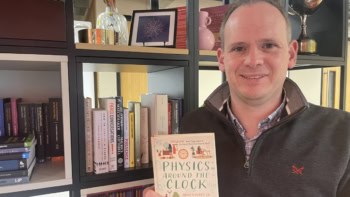By Hamish Johnston
A week ago today, physicists at CERN announced that they have discovered a “Higgs-like” boson. But is it the Higgs boson as described by the Standard Model of particle physics?
The answer to that question is “we don’t know yet”, and the race is on to interpret the results presented last week by the CMS and ATLAS experiments on the Large Hadron Collider (LHC).
Famous for being quick off the mark when new data are available, Dan Hooper of Fermilab has teamed up with colleague Mathew Buckley to look for hints of supersymmetry (SUSY). In a preprint uploaded to arXiv just one day after the announcement, Buckley and Hooper focus on the decay of the Higgs via two gamma rays (the diphoton channel) and via two gluons (the gg channel).
While the diphoton channel is relatively straightforward to study at the LHC, the gg channel cannot be seen because the colliding protons produce so many background particles that the decay cannot be isolated. However, Higgs bosons are produced in the LHC by the reverse process – the fusion of two gluons. The rate at which this fusion occurs is related to the rate at which the Higgs decays to gg.
Unlike other Higgs-producing processes, gg fusion does not produce additional particles such as a W or Z boson. As a result, physicists are able to get a handle on the gg fusion rate by looking at Higgs decays that aren’t associated with these other particles.
Putting all of this together, Buckley and Hooper figure that the diphoton decay rate is about three times higher than predicted by the Standard Model, whereas the gg decay rate is about half of that expected.
What could this mean? The Fermilab pair thinks that it could be emerging evidence for SUSY. Specifically, it could point to the existence of a scalar top supersymmetric quark (stop squark), which is the supersymmetric partner of the top quark. Unlike the top quark, which is by far the heaviest quark, the stop is expected to be a lightweight squark – which Buckley and Hooper say fits their analysis.
You can read the paper here.
Hooper is fast, but not as quick as his Midwestern colleagues Ian Low, Joseph Lykken and Gabe Shaughnessey – who uploaded a paper on 4 July, the day the announcement was made. The paper was uploaded shortly before 20:00 GMT, so assuming the trio had no prior knowledge of the announcement, it must have been written in less than 11 hours!
In their paper on arXiv, the researchers point out that the observed Higgs decay rates are consistent with the existence of a “Higgs imposter” – a particle that looks like a Higgs but isn’t a Higgs.
While both papers are interesting, I should point out that the CMS and ATLAS data are also consistent with a boring old Standard Model Higgs boson, and more data are needed before we know the exact nature of what was discovered last week at CERN.



